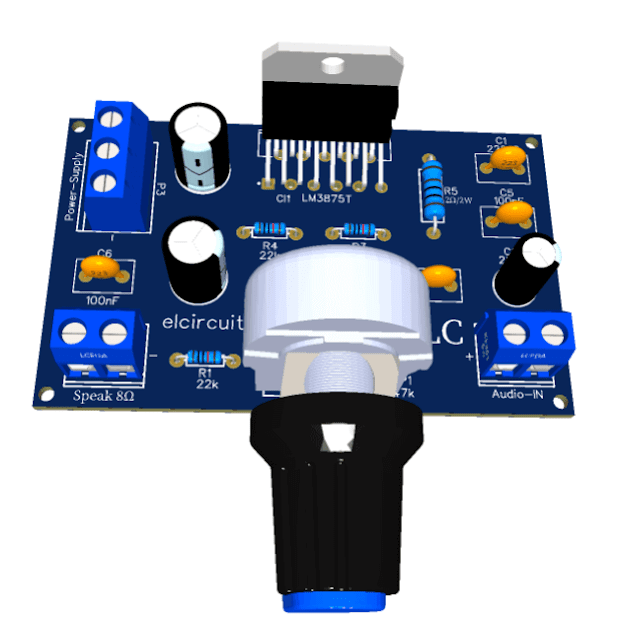 |
| Fig. 1 - PCB 40W Stereo Car Amplifier TDA8560Q |
For Portuguese Version, Click Here!
This is a super easy to build Stereo Car Audio Power Amplifier circuit, due to the number of external components being few, it makes this amplifier quite viable for those who want to build a power amplifier and super simple and quick to do.
The TDA8560Q is an integrated Class-B output amplifier in a 13-lead Single-In-Line (SIL) power package.
This Car Audio Amplifier Circuit gives an output power 2×40W / 2 Ω in BTL configuration. The device is primarily developed for car radio applications.
The TDA8560Q contains two identical amplifiers and can be used for bridge applications. The gain of each amplifier is fixed at 40 dB. Special features of the device are as follows.
You might also be interested in:
- 170W AB Class Bridge Mode Amplifier using TDA7294 IC + PCB
- High Fidelity 14W - 12V Power Amplifier using TDA2030 IC + PCB
- 24W Stereo Hi-Fi Audio Amplifier using TDA2616 + PCB
- HI-FI 120W RMS Amplifier Circuit using LM4780 IC + PCB
- 4 x 50W High Power Amplifier, 14.4V - IC TDA7563A + PCB
- 180W RMS 4-Channel Amplifier with TDA7386 + PCB
- 320W Power Audio Amplifier, Powered with 14.4V - 2Ω with IC TDA7560 + PCB
- 100W RMS Audio Amplifier IC TDA7294 + PCB
- 200W RMS Stereo Power Amplifier with IC STK4231II + PCB
Mode select switch (pin 11)
- Standby: low supply current (<100 µA)
- Mute: input signal suppressed
- Operating: normal on condition.
Since this pin has a very low input current (<40 µA), a low cost supply switch can be applied. To avoid switch-on plops, it is advised to keep the amplifier in the mute mode during ≥100 ms (charging of the input capacitors at pin 1 and pin 13).
The schematic diagram of the Car Amplifier Circuit, is in Figure 2 below, it is a very simple circuit to build, with few external components, however, it is a very powerful circuit, which provides 80W in two 2 Ohms Speakers.
 |
| Fig. 2 - 40W Stereo 14.4V Car Audio Power Amplifier - IC TDA8560Q |
Components List
- U1 ..................TDA8560Q Integrated Circuit
- R1, R2, R3 .... 10K ohms - 1/8 W Resistor - (brown, black, orange, gold)
- C1, C2 ........... 470nF Polyester Capacitor
- C3 .................. 47uF - 35V Electrolytic capacitor
- C4 .................. 2200uF - 35V Electrolytic capacitor
- C5 .................. 100nF Ceramic Capacitor
- RP1, RP2 ....... 20K ohms Potentiometer
- JP1, JP2 .......... Female RCA Connectors to PCB
- P1, P2, P3 ....... PCB Terminal Blocks
- Others ............. Wires, Welds, Posts, PCB, Etc.
Direct link to download
Click in the link to download the Files: PCB Layout, PDF, GERBER, JPG
If you have any questions, suggestions or corrections, please leave them in the comments and we will answer them soon.
Subscribe to our blog!!! Click here - elcircuits.com!!!
My Best Regards!!!































